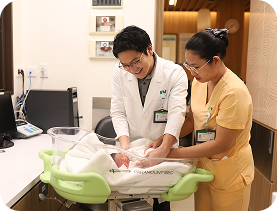During Delivery
Vaginal Birth After Caesarean (VBAC)
Thursday, 02/07/2020 | Maternity | by FV Thomson
WHAT IS VBAC?
VBAC stands for “Vaginal Birth After Caesarean”. It is the term used when a woman gives birth vaginally, having had a caesarean birth (also known as a C-section) in the past.
If you desire to try a vaginal delivery after having had a caesarean (VBAC), you should be encouraged by knowing that approximately 75% of women who have previously undergone caesarean birth can successfully give birth vaginally.
In considering your choices, your obstetrician will ask you about your medical history and about your previous pregnancies. They will want to know about:
- The reason you had the caesarean birth and what happened – was it an emergency?
- How you felt about your previous birth. Do you have any concerns?
- Whether your current pregnancy has been straightforward or have there been any problems or complications?
You and your obstetrician will consider your chance of a successful vaginal birth, your personal wishes and future pregnancy plans when making a decision about vaginal birth or caesarean birth.

WHAT ARE THE RISKS OF REPEATED C-SECTIONS?
C-section is a surgical procedure used to deliver a baby through an incision in the mother’s abdomen and a second incision in the mother’s uterus. C-section may have been necessary for medical reasons, or requested by you to avoid labour or to take advantage of the convenience of a planned delivery.
Repeated C-sections increase the risk of problems in future pregnancies, such as the placenta implanting low in the uterus or the placenta invading the muscle of the uterus, which could result in excessive bleeding leading to hysterectomy. Repeated C-sections can also cause pain and discomfort due to adhesions or scar tissue forming inside; this may lead to infertility, ectopic pregnancies (a complication of pregnancy in which the embryo attaches outside the uterus) or further surgery in the future. Therefore, if you plan to have more babies it is better to try to avoid another C-section if possible.
WHAT ARE THE ADVANTAGES OF A SUCCESSFUL VBAC?
- Greater chance of an uncomplicated normal birth in future pregnancies.
- Shorter recovery and a shorter stay in hospital.
- Less abdominal pain after birth.
- Not having surgery (a repeat C-section usually takes longer than the first operation because of scar tissue. Scar tissue may also make the operation more difficult)
- Your baby will have less chance of initial respiratory problems: breathing problems for your baby are quite common after C-section but usually do not last long, they are rare after VBAC.
- You are more likely to be able to have skin-to-skin contact with your baby immediately after birth and to be able to breastfeed successfully.
WHAT ARE THE CRITERIA TO BE CONSIDERED FOR VBAC?
- No more than two low transverse caesarean deliveries.
- No additional uterine scars, anomalies or previous ruptures.
- If the original medical reason for a caesarean delivery is not repeated with this pregnancy.
- You have no major medical problems.
- The baby is a normal size.
- The baby is head-down.
IN WHAT SITUATIONS WOULD VBAC NOT BE RECOMMENDED?
- You have had three of more previous C-sections.
- You have a high uterine incision.
- Your uterus has ruptured previously.
- Your baby is not presenting head first.
- There are abnormalities of the location or attachments of the placenta.
- You are pregnant with twins and the first foetus is not presenting head first.
- You have gestational diabetes not correctly controlled.
- In case of suspected foetal macrosomia.
- If you have high-blood pressure.
WHAT ARE THE RISKS OF VBAC?
- You may need to have an emergency C-section during labour if your labour slows or if there is a concern for the wellbeing of your baby. This happens in 25 out of 100 women. This is only slightly higher than if you were labouring for the first time, when the chance of an emergency C-section is 20 in 100 women.
- You have a slightly higher chance of needing a blood transfusion compared with women who choose a planned second C-section.
- There is a small risk that during labour the scar on your uterus may tear (rupture). This can occur in 1 in 500 women. This risk increases if your labour is induced. If there are warning signs of these complications, your baby will be delivered by emergency C-section. Serious consequences for you and your baby are rare.
- You may need an assisted vaginal birth using ventouse or forceps.
WHAT CAN YOU EXPECT?
Once you’ve decided to undergo VBAC, you’ll follow the same process that is used for any vaginal delivery during labour. Your doctor will likely recommend continuous monitoring of your baby’s heart rate and be prepared to do a repeat C-section if needed.
WHAT HAPPENS IF I DO NOT GO INTO LABOUR WHEN I’M PLANNING A VBAC?
- If labour does not start by 41 weeks, your doctor will discuss different options with you.
- Induction of labour is an option however it reduces the success rate of achieving VBAC and increases the rate of uterine rupture.
- Women who are contemplating future pregnancies may accept these short-term risks to maximise their chance of vaginal birth, since a successful VBAC will reduce the risks associated with multiple C-sections in future pregnancies.
- Others will choose repeat elective caesarean birth.










